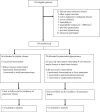Randomized Controlled Trial of Pancreaticojejunostomy versus Stapler Closure of the Pancreatic Stump During Distal Pancreatectomy to Reduce Pancreatic Fistula
- PMID: 26473652
- PMCID: PMC4902322
- DOI: 10.1097/SLA.0000000000001395
Randomized Controlled Trial of Pancreaticojejunostomy versus Stapler Closure of the Pancreatic Stump During Distal Pancreatectomy to Reduce Pancreatic Fistula
Abstract
Objectives: The aim of this study was to evaluate in a multicenter randomized controlled trial (RCT) whether pancreaticojejunostomy (PJ) of pancreatic stump decreases the incidence of pancreatic fistula after distal pancreatectomy (DP) compared with stapler closure.
Background: Several studies reported that PJ of pancreatic stump reduces the incidence of pancreatic fistula after DP. However, no RCT has confirmed the efficacy of PJ of pancreatic stump.
Methods: One hundred thirty-six patients scheduled for DP were enrolled in this study between June 2011 and March 2014 at 6 high-volume surgical centers in Japan. Enrolled patients were randomized to either stapler closure or PJ. The primary endpoint was the incidence of pancreatic fistula based on the International Study Group on Pancreatic Fistula criteria. This RCT was registered with ClinicalTrials.gov (NCT01384617).
Results: Sixty-one patients randomized to stapler and 62 patients randomized to PJ were analyzed by intention-to-treat. Pancreatic fistula occurred in 23 patients (37.7%) in the stapler closure group and 24 (38.7%) in the PJ group (P = 0.332) in intention-to-treat analysis. The incidence of clinically relevant pancreatic fistula (grade B or C) was 16.4% for stapler closure and 9.7% for PJ (P = 0.201). Mortality was zero in both groups. In a subgroup analysis for thickness of pancreas greater than 12 mm, the incidence of clinically relevant pancreatic fistula occurred in 22.2% of the patients in the stapler closure group and in 6.2% of the PJ group (P = 0.080).
Conclusions: PJ of the pancreatic stump during DP does not reduce pancreatic fistula compared with stapler closure.
Conflict of interest statement
Disclosure: The authors declare no conflict of interest.
Figures


Comment in
-
Reply to: The Letter to the Editor "Randomized Controlled Trial of Pancreaticojejunostomy versus Stapler Closure of the Pancreatic Stump During Distal Pancreatectomy to Reduce Pancreatic Fistula".Ann Surg. 2018 Feb;267(2):e38-e39. doi: 10.1097/SLA.0000000000002051. Ann Surg. 2018. PMID: 27763896 No abstract available.
-
Reply to Letter to the Editor "Pancreatic Fistula Following Distal Pancreatectomies. It's better Not Looking for It".Ann Surg. 2018 Mar;267(3):e51-e52. doi: 10.1097/SLA.0000000000002078. Ann Surg. 2018. PMID: 27805966 No abstract available.
-
Pancreatic Fistula Following Distal Pancreatectomies: It's Better Not Looking for It.Ann Surg. 2018 Mar;267(3):e50-e51. doi: 10.1097/SLA.0000000000002075. Ann Surg. 2018. PMID: 27849663 No abstract available.
-
Randomized Controlled Trial of Pancreaticojejunostomy Versus Stapler Closure of the Pancreatic Stump During Distal Pancreatectomy to Reduce Pancreatic Fistula.Ann Surg. 2018 Feb;267(2):e37. doi: 10.1097/SLA.0000000000002032. Ann Surg. 2018. PMID: 27849671 No abstract available.
References
-
- Sledziamowski JF, Duffas JP, Muscari F, et al. Risk factors for mortality and intra-abdominal morbidity after distal pancreatectomy. Surgery 2005; 137:180–185. - PubMed
-
- Goh BK, Tan YM, Chung YF, et al. Critical appraisal of 232 consecutive distal pancreatectomies with emphasis on risk factors, outcome, and management of the postoperative pancreatic fistula: a 21-year experience at a single institution. Arch Surg 2008; 143:956–965. - PubMed
-
- Harris LJ, Abdollahi H, Newhook T, et al. Optimal technical management of stump closure following distal pancreatectomy: a retrospective review of 215 cases. J Gastrointest Surg 2010; 14:998–1005. - PubMed
-
- Diener MK, Seiler CM, Rossion I, et al. Efficacy of stapler versus hand-sewn closure after distal pancreatectomy (DISPACT): a randomised, controlled multicentre trial. Lancet 2011; 377:1514–1522. - PubMed
Publication types
MeSH terms
Associated data
LinkOut - more resources
Full Text Sources
Other Literature Sources
Medical

